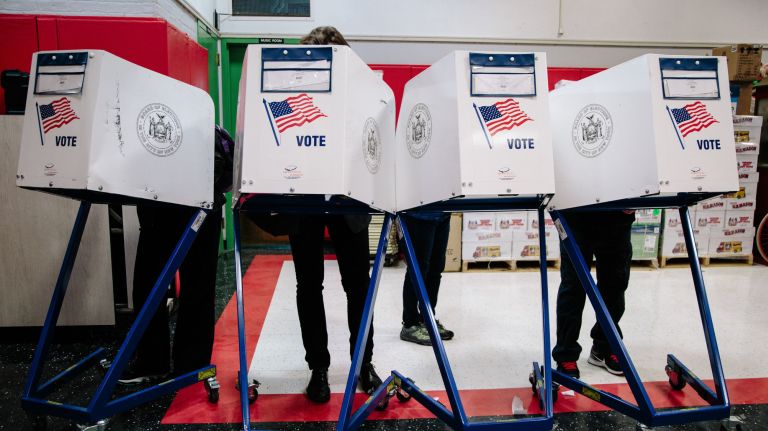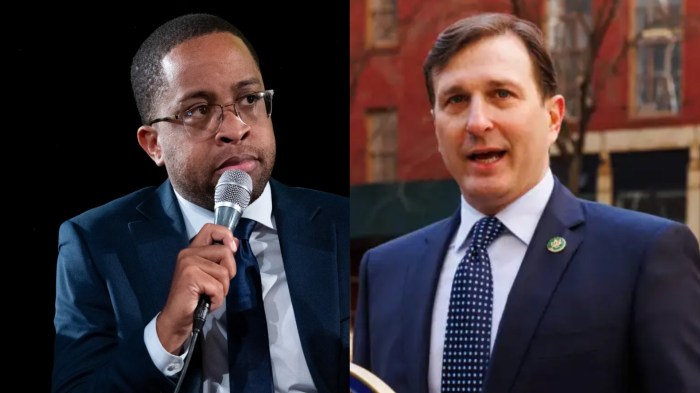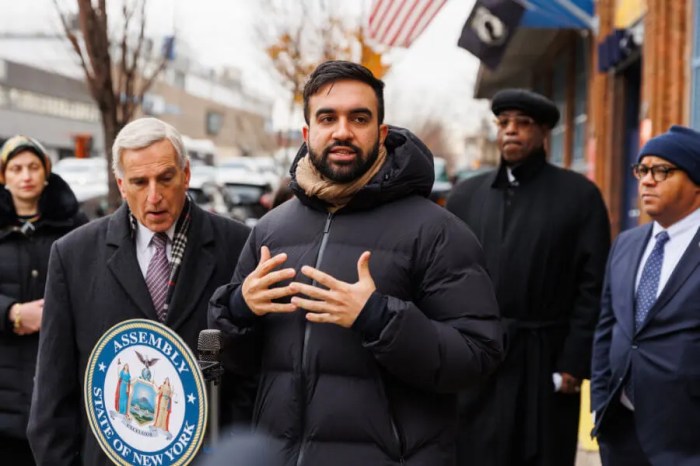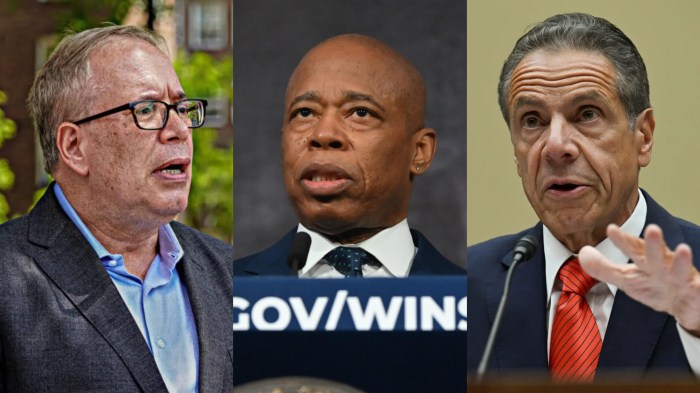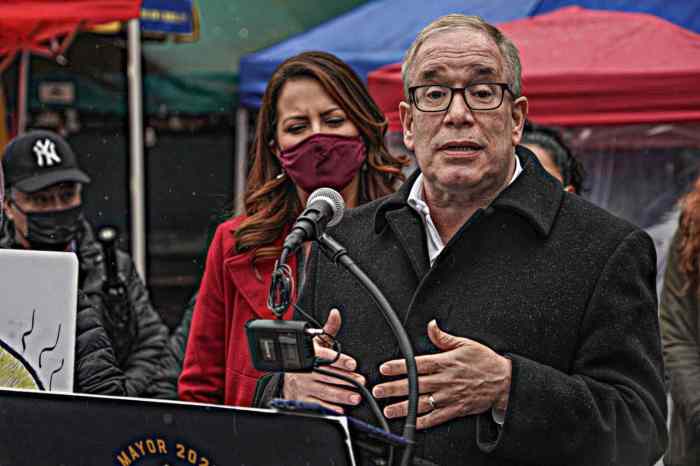New Yorkers rank their favorite pizza toppings, their favorite superhero movies and their favorite boroughs all of the time. Soon they may be doing the same for their candidates.
This year’s general election will include ballot measures that could change the city’s charter, the most significant of which would alter local elections from the standard plurality system — in which the candidate with the most votes wins — to a ranked-choice voting (RCV) system, in which city voters rank candidates and the one with most top-ranked votes wins.
The voting system has been adopted in the state of Maine and local municipalities including Minneapolis and San Francisco. If enacted in New York, political experts, scientists and other advocates say it will drastically change how campaigns are conducted in the city.
“This is a win-win for New Yorkers,” said Susan Lerner, the executive director of Common Cause New York, which has been promoting RCV. “People no longer have to choose the lesser of two evils.”
While experts say no voting system is perfect, they argue that the mechanics of RCV could encourage more active and accurate elections.
The Process
If November’s ballot measure gets more than 50% of the vote, primaries, elections and special elections for City Council, public advocate, city comptroller and mayor will change to RCV starting in 2021.
Under RCV, voters will rank the candidates listed on the ballot from first to fifth. If one candidate has more than 50% of the number one rankings, that candidate wins the race. If there is no majority, then the ballot goes through an instant runoff process.
In this scenario, the candidate with the fewest number of number-one rankings would be eliminated. Ballots listing the removed candidate as the top choice are then revised: The top choice is eliminated, and the second choice is moved up to number one.
The process continues until someone gets the majority.
Christopher Hanusa, associate professor of Mathematics at Queens College, likened the process to going to an ice cream shop.
“You go in and you say ‘Oh I like vanilla, but if they’re out I’ll take chocolate.’” he said. “People rank their choices in everyday life; this is no different.”
Hanusa said candidates have more opportunities to succeed, and it is their interest to get as many number two votes as number one votes if they wish to win the race.
“Someone who is a long shot before doesn’t win because of ranked-choice voting,” he said. “In order to win you have to have a higher preference than others.”
How it’s been used
Minneapolis first adopted RCV for its local elections in 2009, following the passage of a similar ballot initiative. Casey Joe Carl, the city clerk for Minneapolis, said the rollout has been smooth over the last decade.
“We’ve done a survey after each of those elections … and one of those questions was ‘Did you like ranked-choice voting?’” he said. “We found an increase in the number of people who like it and want us to keep using it, each time.”
Carl said that the RCV has had a positive effect on voter turnout. In its first year, 45,968 voters, roughly 20% of eligible voters, participated. Eight years later, 105,928, about 42% of eligible voters, went to the polls.
“I think voters appreciate having more choice in the process,” he said.
Certifying the election in Minneapolis, however, has been a daunting task so far, according to Carl. Officials have to enter the ballots into an Excel sheet which are manually tabulated. In its first year of RCV, it took 15 days to certify the election. However in 2017, officials were able to get it down to 24 hours, Carl said.
Chris Hughes, the policy director of The Ranked Choice Voting Resource Center, a national nonprofit that promotes this voting process, said some states like Maine have utilized specialized voting machines that can tabulate RCV ballots and provide results of the first round by the end of the night.
“I think that if New York were to adopt [RCV] they would be using the same system in Maine,” he said.
New York political experts say there are plenty of benefits and challenges to consider.
Impact on New York
Doug Muzzio, a professor of political science at Baruch College who has written a paper on RCV, said that there are several advantages for voters if the ballot measure is passed.
First, RCV would save the city time and money by avoiding costly runoff elections in tight races, he said. The 2013 runoff election for the Democratic primary for public advocate, an office that only has a budget of $3.6 million a year, cost taxpayers over $13 million according to city records.
“This will help voters, because they will get the final results faster,” he said.
On the campaign side, Muzzio and other experts say it will push political candidates, especially ones in the primaries, to reach out to a broader range of people. Campaigning to a base won’t help a candidate get votes in the lower ranks on the ballot, and if a ballot is loaded with many contenders, having those number two and number three rankings will make the difference, he said.
“What is going to happen is you’re going to place a broader emphasis on being the second-place finisher,” Muzzio said. “They’ll have to campaign to more voters so they can be seen as a good choice, even if they aren’t the voter’s first preference.”
Muzzio did say there could problems imposing the system in New York, based on the questionable performance of the city’s Board of Elections. The board’s disorganization has led to major problems in the past, such as thousands of voters having their ballots disqualified in the 2016 presidential primary, and snafus last year with the voting machines during the general election.
“With the incompetence of the Board of Elections, you could end up in a mess or a lot of people staying at home,” he warned.
Hughes said he has studied many municipalities’ transitions to RCV and that the learning curve isn’t generally too steep. Overall, voters have been more open to head to the polls if one of their candidates has a chance, even if it means they get a second-place ranking.
“The big take away we’ve seen is that it’s made for more civil elections,” he said. “[Voters] feel it is more issue-focused.”
Hughes added that if the city’s ballot measure passes, it would triple the number of American voters who use RCV, and if successful, could lead to other municipalities and even states taking it on.
“I think this movement around the country is showing that Ranked Choice Voting is an idea that’s time has come,” he said.



